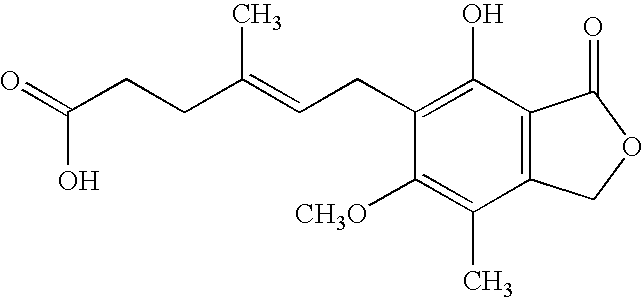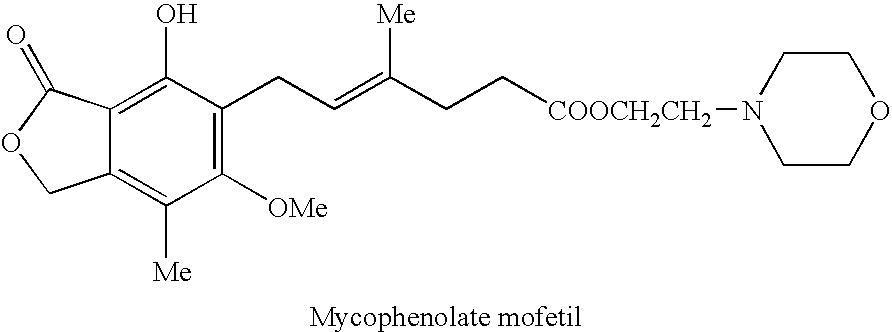Mycophenolate mofetil impurity
a technology of mycophenolate and impurities, applied in the field of mycophenolate mofetil impurities, can solve the problems of mpa withdrawal, high incidence of side effects, and various impurities
- Summary
- Abstract
- Description
- Claims
- Application Information
AI Technical Summary
Problems solved by technology
Method used
Image
Examples
example 1
Preparation of N-(2-mesylethyl)morpholine
[0086] A 150 ml one-necked round bottomed flask equipped with magnetic bar and equipped with CaCl2 tube on its top, was charged with 5.2 g N-(2-hydroxyethyl)morpholine, 25 ml DCM, and 5.5 ml triethylamine. The mixture was stirred and cooled in an ice-water bath while 3.1 ml of mesylchloride was added over a period of 5 min. The reaction mixture was stirred overnight and then quenched in 20 ml water. The aqueous layer was extracted with two 25 ml DCM portions, and the combined organic extracts were washed with 20 ml of brine, dried over MgSO4, and concentrated under reduced pressure to give 4.1 g of the crude mesylate which is pure by TLC.
example 2
Preparation of Compound 1
[0087] A 150 ml two-necked round bottomed flask with a magnetic stirrer and a nitrogen gas inlet, was charged with 6.21 g mycophenolate mofetil (14.3 mmol) and 20 ml anhydrous DMF. To the stirred solution was added portion wise 570 mg sodium hydride (60% in mineral oil) over a period of 10 min, and the resulting mixture was stirred for 25 min at room temperature. To the reaction mixture was added mesyl derivative, 2.92 g (14 mmol) in 4 ml DMF. The reaction mixture was heated in a 50° C. oil bath for 14 hrs, and then allowed to cool to room temperature, diluted with 50 ml water, and extracted with three 20 ml portions of ethyl acetate. The combined organic extracts were washed with brine (20 ml), dried, and concentrated under reduced pressure to give 7 g (89%) pale viscous yellow liquid as a pure product (by TLC analysis). Further purification can be conducted by column chromatography on silica gel and elution with DCM / MeOH (95:5).
example 3
Preparation of Compound 1
[0088] Combined aqueous acetic washings (5 l) derived from the production of crude MMF were neutralized with solid sodium bicarbonate. Isobutyl acetate (1 l) and charcoal (10 g) were added, filtered, and the phases were separated. The organic phase was evaporated to 300 ml. Water (300 ml) was added, and the pH was adjusted to 4-4.5 using acetic acid. After separation of phases, the aqueous phase was neutralized with solid sodium bicarbonate and extracted with isobutyl acetate (200 ml). The organic phase was dried on sodium sulfate and evaporated to dryness. The purity of the residue (0.81 g brownish oil) was 77 a % of Compound 1.
[0089] The residue was chromatographed on a column of silica gel (eluent: acetone) to produce a syrupy product, Compound 1 (560 mg, purity: 95 a %).
PUM
| Property | Measurement | Unit |
|---|---|---|
| temperature | aaaaa | aaaaa |
| temperature | aaaaa | aaaaa |
| temperature | aaaaa | aaaaa |
Abstract
Description
Claims
Application Information
 Login to View More
Login to View More - R&D
- Intellectual Property
- Life Sciences
- Materials
- Tech Scout
- Unparalleled Data Quality
- Higher Quality Content
- 60% Fewer Hallucinations
Browse by: Latest US Patents, China's latest patents, Technical Efficacy Thesaurus, Application Domain, Technology Topic, Popular Technical Reports.
© 2025 PatSnap. All rights reserved.Legal|Privacy policy|Modern Slavery Act Transparency Statement|Sitemap|About US| Contact US: help@patsnap.com



